
Study: Vyšehrad Bridge can be repaired with minimal impact on traffic
Publisher
ČTK
31.10.2024 18:25
ČTK
31.10.2024 18:25
Czech Republic
Prague
Vyšehrad
Petr Tej
Marek Kopeć
Ian Firth
Andreas Galmarini
Prague – The Vyšehrad railway bridge can be repaired in such a way that the work, including preparations, will take four years and cause minimal disruption to operations. A third track can be added by constructing a narrow platform on the side of the bridge. This follows from a study commissioned by the Foundation for the Preservation of the Vyšehrad Bridge, which its authors presented today. According to them, only 15 percent of the steel in the bridge needs replacement, and with the addition of the third track, modifications to the surroundings, and a new stop at Vyšehrad, the work would cost about 2.5 billion crowns. A dispute arose regarding the monument-protected bridge, as the Railway Administration (SŽ) wants to replace its structure with a new one, while local groups and municipalities are calling for a reconstruction. SŽ Director Jiří Svoboda stated that the organization will consider the proposals presented.
The proposal for the reconstruction of the bridge and modifications to its surroundings was developed for the foundation by British bridge engineer Ian Firth, Swiss expert Andreas Galmarini, and Czech architects Petr Tej and Marek Kopeč. According to the representatives of the foundation, the aim of the study is to offer the state a way to preserve the bridge in its current form. "We don't want to dictate what should and shouldn't be done; we simply offer an option," said Tomáš Bistřický on behalf of the foundation.
"This case is by no means exceptional; I have seen many bridges in much worse condition that were able to be saved," Firth stated today. Galmarini added that, according to a site survey, a large part of the steel structure is in good condition, with significant corrosion only found in specific areas.
According to the authors of the study, the proposal would preserve the original form of the bridge, only expanding the pathways for pedestrians and cyclists and modifying the drainage. The reconstruction would bring minimal disruption to operations on the bridge, as workers would gradually lower each of the three bridge segments to the bank for repairs and replace them with a temporary structure, which would only take a few days each time. Trains could continue to run over the bridge during the remainder of the time.
"We can fit within a four-year timeframe – two years for preparation, two years for reconstruction," Tej further stated on behalf of the authors. According to him, the repaired structure from 1901 should have a lifespan of another 100 years. The study also accounts for the addition of the third track, which is requested by SŽ and the city. It would take the form of a narrow platform with pillars on the southern side of the bridge towards Vyšehrad.
SŽ Chief Svoboda contributed to the panel discussion from the audience, stating that the company is primarily concerned with ensuring the practical operation of trains. "I view it from the perspective of what the railway needs to ensure in Prague – safety, capacity, and development," he stated. He added that the organization will look into the documentation and especially the information about the only 15 percent degradation of the structure. "We will work with that," he said.
The study also includes modifications to the Smíchov and Výtoň forebays, including public spaces and transportation solutions. The urban planning part of the proposal was done by Kopeč, who said that public spaces, tree-lined avenues, or transportation connections would be created on both sides. At Výtoň, it would be possible to utilize the spaces between the bridge's pillars for shops or cafes.
Instead of the new train stop at Výtoň, as planned by SŽ, the proposal allows the trains to stop at the original location near the former Vyšehrad station. "The advantages are so evident that I believe there shouldn't be any discussion about it," Kopeč said. He added that the solution would also allow for the access to the currently essentially closed Vnislavova Street that runs alongside the tracks. If his proposal were implemented, a total of 3,700 square meters of new non-residential space would be created, the urban planner added.
Jiří Kolísko, director of the Klokner Institute of the Czech Technical University, also spoke during the discussion; he previously prepared a study recommending the replacement of the structure. According to the director, it was always known that the bridge was theoretically repairable, but it was a matter of whether it was worth it. From this perspective, as well as in terms of cost comparability between both solutions, he remains skeptical.
Another organization advocating for the preservation of the bridge, the initiative "Don't Demolish," previously filed a criminal complaint due to what they claimed was neglected maintenance of the structure. The police dismissed it, and the organization turned to the public prosecutor’s office, where they also were unsuccessful. "Such a complaint was indeed filed and addressed by the local public prosecutor's office, with the conclusion that the organization Don't Demolish does not have the right according to the Criminal Procedure Code to request a review of the actions of the police authority by the public prosecutor," said Tomáš Svoboda, head of the District Public Prosecutor's Office for Prague 2, in response to ČTK's inquiry.
In contrast, the organization Výtoň 21 supports the new bridge and criticized today's presentation. Some of the study's authors, according to the association, participated a few years ago in an international architectural competition for the modernization of the bridge and did not succeed with their proposals. "This casts significant doubts on the objectivity of the currently presented study. It is not just about individuals but also about some foreign companies," the organization stated, referring to its earlier statement.
SŽ is currently seeking designers for the new structure that is to replace the current bridge. The administration plans the work for the years 2027 to 2029 and estimates the costs at 3.4 billion crowns. The current monument-protected structure, according to preliminary plans, is to be relocated upstream of the Vltava River between Modřany and Velká Chuchle, where it will continue to serve as a footbridge for pedestrians and cyclists. The plan to replace the bridge has long been criticized by Prague municipalities, conservationists, the Don't Demolish organization, and the Czech National Committee of the International Council on Monuments and Sites (ICOMOS).
The proposal for the reconstruction of the bridge and modifications to its surroundings was developed for the foundation by British bridge engineer Ian Firth, Swiss expert Andreas Galmarini, and Czech architects Petr Tej and Marek Kopeč. According to the representatives of the foundation, the aim of the study is to offer the state a way to preserve the bridge in its current form. "We don't want to dictate what should and shouldn't be done; we simply offer an option," said Tomáš Bistřický on behalf of the foundation.
"This case is by no means exceptional; I have seen many bridges in much worse condition that were able to be saved," Firth stated today. Galmarini added that, according to a site survey, a large part of the steel structure is in good condition, with significant corrosion only found in specific areas.
According to the authors of the study, the proposal would preserve the original form of the bridge, only expanding the pathways for pedestrians and cyclists and modifying the drainage. The reconstruction would bring minimal disruption to operations on the bridge, as workers would gradually lower each of the three bridge segments to the bank for repairs and replace them with a temporary structure, which would only take a few days each time. Trains could continue to run over the bridge during the remainder of the time.
"We can fit within a four-year timeframe – two years for preparation, two years for reconstruction," Tej further stated on behalf of the authors. According to him, the repaired structure from 1901 should have a lifespan of another 100 years. The study also accounts for the addition of the third track, which is requested by SŽ and the city. It would take the form of a narrow platform with pillars on the southern side of the bridge towards Vyšehrad.
SŽ Chief Svoboda contributed to the panel discussion from the audience, stating that the company is primarily concerned with ensuring the practical operation of trains. "I view it from the perspective of what the railway needs to ensure in Prague – safety, capacity, and development," he stated. He added that the organization will look into the documentation and especially the information about the only 15 percent degradation of the structure. "We will work with that," he said.
The study also includes modifications to the Smíchov and Výtoň forebays, including public spaces and transportation solutions. The urban planning part of the proposal was done by Kopeč, who said that public spaces, tree-lined avenues, or transportation connections would be created on both sides. At Výtoň, it would be possible to utilize the spaces between the bridge's pillars for shops or cafes.
Instead of the new train stop at Výtoň, as planned by SŽ, the proposal allows the trains to stop at the original location near the former Vyšehrad station. "The advantages are so evident that I believe there shouldn't be any discussion about it," Kopeč said. He added that the solution would also allow for the access to the currently essentially closed Vnislavova Street that runs alongside the tracks. If his proposal were implemented, a total of 3,700 square meters of new non-residential space would be created, the urban planner added.
Jiří Kolísko, director of the Klokner Institute of the Czech Technical University, also spoke during the discussion; he previously prepared a study recommending the replacement of the structure. According to the director, it was always known that the bridge was theoretically repairable, but it was a matter of whether it was worth it. From this perspective, as well as in terms of cost comparability between both solutions, he remains skeptical.
Another organization advocating for the preservation of the bridge, the initiative "Don't Demolish," previously filed a criminal complaint due to what they claimed was neglected maintenance of the structure. The police dismissed it, and the organization turned to the public prosecutor’s office, where they also were unsuccessful. "Such a complaint was indeed filed and addressed by the local public prosecutor's office, with the conclusion that the organization Don't Demolish does not have the right according to the Criminal Procedure Code to request a review of the actions of the police authority by the public prosecutor," said Tomáš Svoboda, head of the District Public Prosecutor's Office for Prague 2, in response to ČTK's inquiry.
In contrast, the organization Výtoň 21 supports the new bridge and criticized today's presentation. Some of the study's authors, according to the association, participated a few years ago in an international architectural competition for the modernization of the bridge and did not succeed with their proposals. "This casts significant doubts on the objectivity of the currently presented study. It is not just about individuals but also about some foreign companies," the organization stated, referring to its earlier statement.
SŽ is currently seeking designers for the new structure that is to replace the current bridge. The administration plans the work for the years 2027 to 2029 and estimates the costs at 3.4 billion crowns. The current monument-protected structure, according to preliminary plans, is to be relocated upstream of the Vltava River between Modřany and Velká Chuchle, where it will continue to serve as a footbridge for pedestrians and cyclists. The plan to replace the bridge has long been criticized by Prague municipalities, conservationists, the Don't Demolish organization, and the Czech National Committee of the International Council on Monuments and Sites (ICOMOS).
The English translation is powered by AI tool. Switch to Czech to view the original text source.
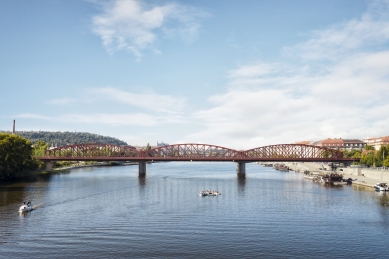
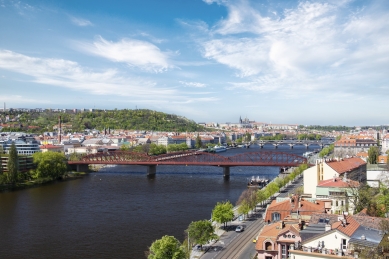
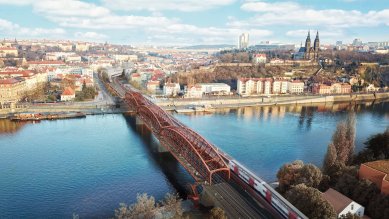
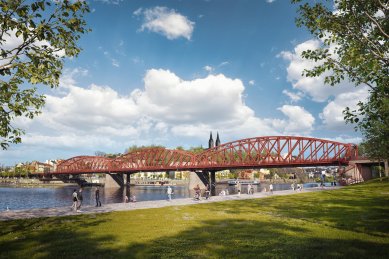
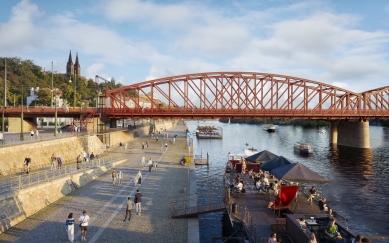
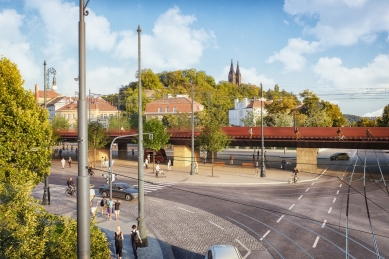
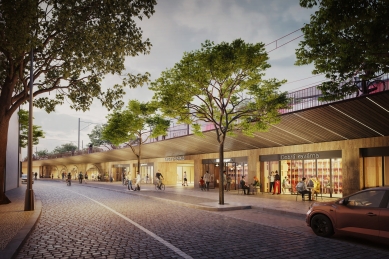
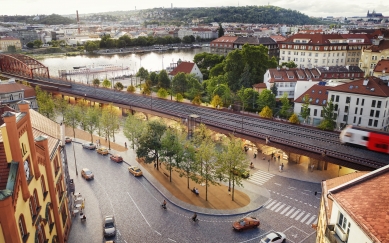
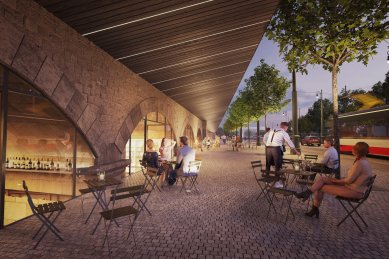
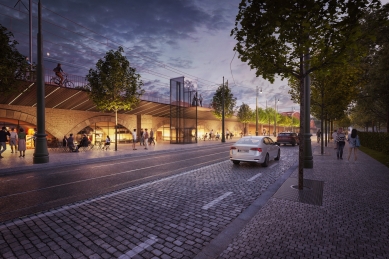
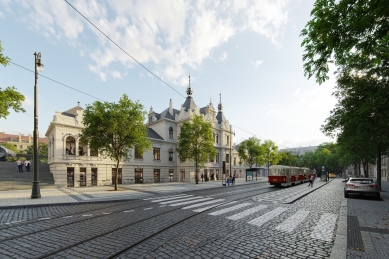
0 comments
add comment
Related articles
0
25.04.2025 | The UNESCO advisory mission recommended the reconstruction of the Vyšehrad Bridge
0
09.01.2025 | The project of the new railway bridge at Výton will cost 128.7 million crowns
0
13.12.2024 | The UNESCO advisory mission discussed the bridge under Vyšehrad in Prague
0
10.10.2024 | In the construction of the bridge at Výtoň, according to monitoring, the first crack has appeared, stated SŽ
0
12.08.2024 | <radní>Councilor: The construction of the bridge at Výtoň should be moved to the Modřany weir</radní>
0
25.07.2024 | The Heritage Council does not like the environmental impact announcement for the bridge at Výton
0
18.07.2024 | The association will turn to the state prosecutor's office regarding the railway bridge at Výtoň
0
16.07.2024 | Police will not pursue prosecution for negligence in maintaining the railway bridge at Výtoň
3
19.12.2023 | <Praha offered assistance in searching for a possible new location for the railway bridge.
0
14.12.2023 | Central Bohemian Region and transporters request a new railway bridge at Prague's Výtoň
0
13.12.2023 | Specialists will prepare a study of the bridge at Prague's Výtoň for free and hand it over to Kupka
1
30.11.2023 | Repairing the bridge at Výton was supported by 20 percent of respondents in the survey for SŽ
5
13.03.2023 | Prague councilors will discuss the bridge at Výtoň; experts have recommended a replacement
0
03.03.2023 | Ministr Kupka is learning about the results of the experts' colloquium on the railway bridge
0
20.02.2023 | The only possible option is to repair the Vyšehrad Bridge











